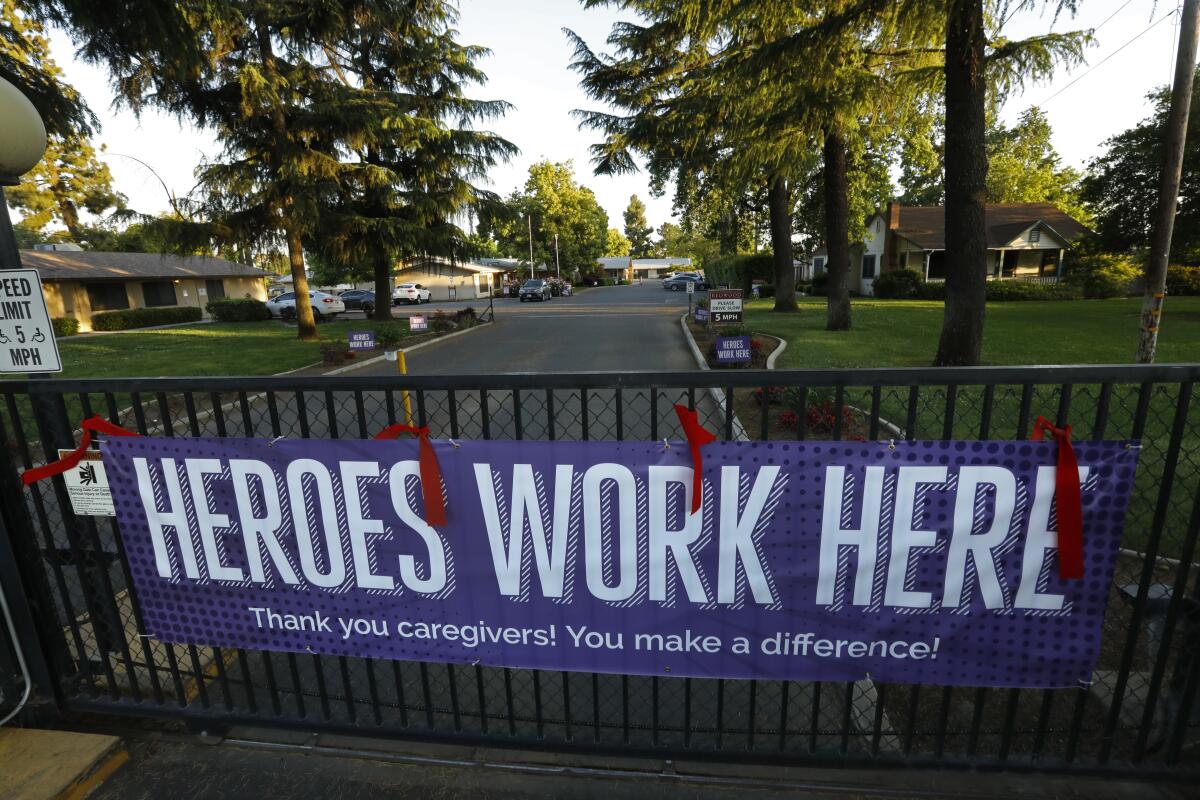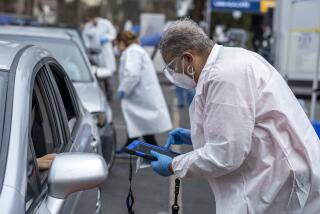Senior care homes source of nearly half of all California coronavirus-related deaths, data show

- Share via
SACRAMENTO — Nearly half of all deaths related to COVID-19 in California are linked to elder care facilities, a data analysis by the Los Angeles Times has found, with the state releasing new data suggesting that there have been many more outbreaks than previously disclosed.
At least 1,276 people have died after being infected with the coronavirus in skilled nursing or assisted living facilities in California, accounting for more than 49% of total fatalities reported by the state.
The deaths are part of state data showing that at least 387 skilled nursing or assisted living facilities in California, many clustered in Los Angeles, have recorded cases.
The highest death toll in the state remains at Redwood Springs Healthcare Center in Tulare County, where 28 residents have died and 116 patients and 61 staff members have been infected.
The facility’s parent company, Plum Healthcare Group, said in a statement last week that the “safety and well-being of our clients and their efforts to care as well as protect patients and caretakers are our highest priorities during this national emergency.”
But there are questions about the accuracy of the state’s data. Earlier Friday, the state had listed Studio City Rehabilitation Center as the facility linked to the highest number of fatalities in California, with 31 dead. That, however, was disputed by the facility, which said it has had only three COVID-19 deaths, numbers in line with county figures.
Liz Tyler, a representative for Studio City Rehabilitation, said the home had accurately reported to the state and did not know where the error occurred. “We have no idea,” Tyler said. “We think they added a zero or something.”
By Friday evening, the state had changed the facility’s listing to reflect fewer than 11 deaths — its standard when the number is 10 or smaller. But it gave no explanation.
Charlene Harrington, a UC San Francisco professor who studies nursing homes, said the numbers are “scary” but not surprising. Harrington said more state oversight and testing is needed to protect facilities from outbreaks.
“The government and the nursing homes are not doing what they need to do to stop it,” Harrington said. “What they are doing now is just waiting until someone gets sick and then testing, so you can’t get in front of it. You have to test ahead of time because so many staff and so many residents are asymptomatic.”
During a Friday briefing on Facebook, Gov. Gavin Newsom called elder care facilities a “top priority.”
Dr. Mark Ghaly, the state’s secretary of Health and Human Services, said during the briefing that California was continuing to work to expand testing in elder care homes and that the expansion of testing in recent days in some cases targeted communities with elder care facilities. But he acknowledged that more testing capacity was needed.
Do you have information you want to share - securely, your identity protected - with reporters for The Times? If so, use our Tip Line.
“I look forward to the day when we have no site that has a limit to its testing capacity,” Ghaly said.
In Los Angeles County, health officials have called for widespread testing in nursing homes. Numbers of reported cases could be higher for homes in Los Angeles County because public health director Barbara Ferrer announced late last month that nursing homes would be advised to test all residents and staff, not just those who show symptoms. The previous guidance, to test only those who showed symptoms, was a mistake, Ferrer said.
Testing only people with symptoms, experts say, probably resulted in a significant undercount of cases at nursing homes, where the ever-climbing number of people falling ill and dying is already a national tragedy.
Other institutional settings in California have also been hit particularly hard, most notably federal prisons.
The number of inmates infected with the coronavirus at a federal prison in Lompoc shot up to 792 this week, making it the largest federal penitentiary outbreak in the nation, surpassing a facility on Terminal Island in San Pedro, where 644 inmates have contracted the virus.
Nearly 70% of the inmates at Federal Correctional Institution Lompoc have tested positive, with the case total increasing by more than 300 in recent days, officials said Friday. FCI Lompoc and Terminal Island now account for about 47% of all the federal inmates who have tested positive nationwide. Both prisons have conducted widespread testing of hundreds of inmates, even those without symptoms.
Santa Barbara County Supervisor Gregg Hart on Friday expressed dismay with the prison and said that the county’s Public Health Department has no power over the federal prison complex. “We have been consistently rebuffed by prison authorities,” he said.
The numbers coming out of FCI Lompoc are so high that the prison accounted for all but one of the 311 new cases reported in Santa Barbara County on Friday, Hart said.
Hart said the prison numbers are making it hard for the county to meet Newsom’s new requirements for reopening parts of the state. Hart said state legislators from the area are talking to officials in the governor’s office.
Dr. Henning Ansorg, Santa Barbara County’s public health officer, said about 70% of the inmates’ tests at the Lompoc prison are coming back positive.
“The vast majority of positive individuals report minor or no symptoms,” Ansorg said. The numbers are reflective of an institutional environment where people are housed in close quarters. He said the actual numbers at the prison may be higher because there is a lag time in reporting.
Some of the inmates infected at Lompoc have been hospitalized. Santa Barbara County has 1,032 cases with about 80% being in the federal prison complex.
At the California Institution for Men in Chino, four inmates have died and 332 have tested positive in the state prison system’s worst documented outbreak as mass testing has been deployed.
The wife of one inmate, who asked not to be identified, said that once her husband contracted the virus at Terminal Island, he was taken to a San Pedro hospital, but it took her days to find out where he was sent. She said she didn’t learn how serious his condition was until she spoke with a hospital chaplain.
The woman said her husband survived the illness and is now back at the prison but struggling to recover.
“He is very weak,” she said. “He fell down in the shower.”
More to Read
Sign up for Essential California
The most important California stories and recommendations in your inbox every morning.
You may occasionally receive promotional content from the Los Angeles Times.















